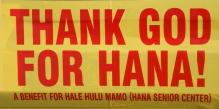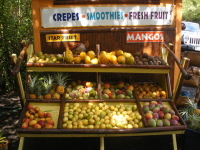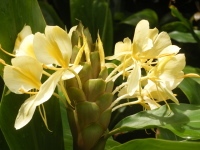Spare Change
The constant allure of East Maui stirs introspection
by Rob ParsonsAugust 6 , 2009
(Unedited version of Mood Swing)
 |
 |
 |
“Thank God for Hana.” –bumper sticker
A cloak of rain clouds shrouded the Alenuihaha Channel between Hana and the Big Island, and squalls blew across the choppy ocean waters. Looking down over steeply sloping pastures, we watched the advancing showers race towards the shoreline far below, where surging waves from Tropical Storm Lana, far to the south, crashed audibly against the lava rocks, sending cascades of whitewater into coastal tide pools.
The moment held a timeless quality, when little mattered beyond the sensory experience of heavy weather rolling in, with fluttering palm fronds in a rippling hula dance, and wind-driven sheets of rain drenching everything in their path. It was perfect. We had no agenda for our two days in Hana, and no expectations of rain or shine; we were ready to soak in either, or as it turned out, both.
Heather and I left Haiku around 2pm on Friday afternoon, picking a time when our leisurely drive encountered a remarkable dearth of traffic in either direction on the windy road. With more curves than a beauty pageant competition, the Hana Highway is also a bit of a misnomer: to the thousands of rental cars yearly that traverse the scenic, sometimes treacherous road, there is little that resembles the fast-moving turnpikes back home.
 |
 |
 |
Being “on assignment” meant that we took our sweet time, stopping at many of the roadside fruit stands along the way, on our own little photo safari. Smiling Aina, working inside the refurbished school bus at the bustling Twin Falls fruit and smoothie stand, was more than happy to accommodate my picture-taking, leaning out the window with her chin resting on her hands, elbows on the makeshift counter. A short ways further, the Huelo Point stop displayed a luscious array of papayas, bananas, and mangoes, while their hand-lettered sign also advertised crepes.
Similarly, we noticed that each roadside stand had unique elements to attract travelers to stop. Colorful signs beckoned with sumptuous offerings to be found within: “Passion Fruit”; “Strawberry Papayas”; “Fresh Coconuts & Organic Fruits”; “Hawaiian Guri Guri Ice Cream”; “6 Varieties Banana Bread”; “Smoked BBQ”; “Steamed Breadfruit”; and my favorite, “Honk if you’re hungry.”
Clusters of yellow and white ginger lined the road banks, perfuming the air.
The drive was a transfixing, transforming meditation, with the requisite pauses at the one-lane bridges to show courtesy to other drivers. On particular stretches of the highway, my thoughts drifted back to memories of running the curves and hills with my Hana relays teammates, in the years before one of my knees developed a wonky sort of click.
On a straightaway not far past the Keanae Arboretum, to my amazement, an `iwa bird soared a few feet above us for a couple hundred yards. Observing the great frigate bird, its common name, is thought by some to foretell an approaching storm, such as the 1982 hurricane that battered the island of Kauai, bearing the seabird’s Hawaiian name.
Later, high above the cliffs at Koki Beach past Hana town, at least forty `iwa birds rode the gusty breezes, circling in concentric orbits. Another dozen or so stretched their long wings over the promontory of Alau Islet, where they nest.
I pondered to what degree my own moodiness of the previous day had been a product of the barometric shift from the passing storm to the south. Unable to determine the source of my unsettling funk, I trusted that time spent in Hana would serve to sooth my spirit.
I am continually amazed by Hana’s botanical lushness, cultural richness, magical vistas, sparkling prana-filled beaches, and unwavering sense of place. Geographic isolation and high real estate prices are two obvious reasons why the region has changed little over the years.
Cottages now dot the bluff below the ballpark, an adjunct of the Hotel Hana. A few more luxury homes are now tucked into the hillsides. But a golf course proposed years ago never passed the community’s muster, and ownership changes of the ranch and hotel regularly bring modifications, but not overall conversions to Hana’s economic engine and heart of the community.
On this Saturday morning, many have donned aloha attire finery to bid farewell to one of Hana’s matriarch’s Gertrude Boerner, who passed away a month short of her 99th birthday. Her son Chuck has done well at spreading Hana’s tropical fruit bounty throughout Maui and beyond. His Ono Organic Farms now sets up a daily stand at the parking lot where the original Hasegawa General Store stood before burning down back in 1990.
Heather and I headed away from town, driving through alternating drizzle and sunshine towards Kipahulu. We huddled under the Ho`onanea Farm stand, trying to stay dry while Julie cheerfully made us a veggie taco. We bought a ripe egg fruit, and upon tasting it later, wished we’d bought the entire box.
The Haleakala National Park Center at Oheo Gulch was bustling with activity from rental cars, tour vans, and a construction project requiring large new cement slabs being poured just ocean side of the road. We passed by without stopping. On the very next hill, a procession on horseback met us on the road, with a smiling local family, perhaps visiting from Oahu, giving us shakas as we inched by them.
We visited the Laulima Farm stand, set amidst a colorful patchwork of terraced gardens. Inside, a stationary bike is hooked up to a blender, so customers can generate enough electricity to mix their own fruit smoothie. In the corner stood an enormous jackfruit, prickly green and nearly as tall as the four-legged stool beside it. “Yeah,” said the counter girl, recognizing my astonishment, “that one weighs more than fifty pounds.”
The lush jungle suddenly gave way to the bare cliff-side where repairs from rocks loosened by the October, 2006 earthquake had required a protracted road closure. Now, the wire draping on the pali resembles a giant hukilau net, as if a Hawaiian demigod hung it there to dry.
We parked under a hala tree just past Alelele bridge, where the stream waters trickle through the smooth river rocks and into the crashing waves. Pausing to honor the sacredness of the place, we wrapped small stones in ti leaves as we entered the valley, murmuring our thanks to the ancestors of this land.
 |
 |
 |
A nearly hidden path brought us past old stacked rock walls, now covered with mosses and ferns under tall spreading kukui and noni trees. Knee high awapuhi ginger brushed our legs as we headed up the stream. In a few short minutes, we were at the foot of Alelele Falls, water cascading seventy feet down into the pool before us.
Heather calls this place, “Amma’s Pool,” after swimming here ten years ago and losing a mala-necklace that had been blessed by her spiritual guru. The following night she was playing music at a triple birthday party in Kihei when I arrived to hear her sing, “and just then, the moon eclipsed the sun….” It was the sweet beginning of many wonderful things.
With little warning, clouds covered the sun and the temperature abruptly dropped. Winds swept into the valley, bringing sheets of rain, and sending us scampering to the lee side of the valley wall to stay dry, in a small grotto overhang.
In minutes, the weather cleared again, and we traipsed out, pausing to pick a couple maunaloa flowers, a locally-found sweet pea prized by lei-makers. Heather hung one pink flower on each of her gold hoop earrings, a delicate reminder of our adventure hike.
Dinner at Karen Davidson’s home above Mu`olea Point featured a fabulous baked pumpkin from the Hana Fresh garden stand in front of the Hana Health Center (also a benefit for that community endeavor). Satiated with good food and company, we retired to bed early in her art studio. There, colorful hand-crafted paper sculptures of florals, landscapes and abstracts adorned the walls above, eliciting wildly imaginative dreams, while squalls beat their intermittent rhythms on the roof throughout the night.
Sunday morning featured a whim of a recipe conceived the night before: pumpkin pancakes with fresh mangoes! As we sat around the dining table, Karen asked, “Doesn’t it seem as though the recession is starting to ease up?”
“Not really,” I answered without hesitation. At least, I couldn’t come up with any clear indications of a positive upturn.
 |
 |
 |
Of the many roadside signs we observed the previous day, one in particular had caught my eye. On a sharp turn between Hana and Kipahulu, a yellow reflector was affixed to a large mango tree trunk. In the center of the reflector, a bumper sticker in black gothic letters offered a one-word mantra: “Change.”
Change needn’t be scary or imposing, but clearly it is an element of human nature that change is integrated only sparingly, and often with great resistance.
In nature, change is constant. The weather changes from moment to moment, cycles of life are in flux and transition, mango trees bloom, set fruit, ripen then drop and rot. Yet there is a homeostasis in the unfolding magic that is the glue for the constancy of the world. In Hana, the molecules of change are imbued within the ginger blossoms, moist breezes, smiles of strangers, and even the lava rocks.
Perhaps it is because the mountaintops that are the backdrop for Hana are in the clouds that the place is referred to as, “Heavenly Hana,” A more fitting description, or a more sublime locale, would be hard to find.